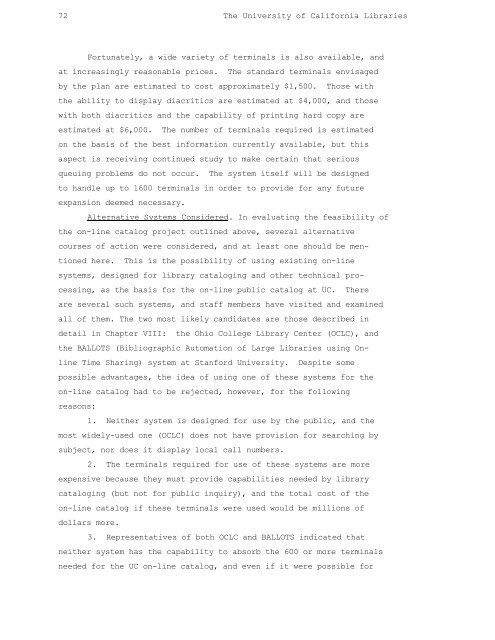The University of California Libraries: A Plan for Development (1977)
The University of California Libraries: A Plan for Development (1977)
The University of California Libraries: A Plan for Development (1977)
You also want an ePaper? Increase the reach of your titles
YUMPU automatically turns print PDFs into web optimized ePapers that Google loves.
72 <strong>The</strong> <strong>University</strong> <strong>of</strong> <strong>Cali<strong>for</strong>nia</strong> <strong>Libraries</strong><br />
Fortunately, a wide variety <strong>of</strong> terminals is also available, and<br />
at increasingly reasonable prices. <strong>The</strong> standard terminals envisaged<br />
by the plan are estimated to cost approximately $1,500. Those with<br />
the ability to display diacritics are estimated at $4,000, and those<br />
with both diacritics and the capability <strong>of</strong> printing hard copy are<br />
estimated at $6,000. <strong>The</strong> number <strong>of</strong> terminals required is estimated<br />
on the basis <strong>of</strong> the best in<strong>for</strong>mation currently available, but this<br />
aspect is receiving continued study to make certain that serious<br />
queuing problems do not occur. <strong>The</strong> system itself will be designed<br />
to handle up to 1600 terminals in order to provide <strong>for</strong> any future<br />
expansion deemed necessary.<br />
Alternative Systems Considered. In evaluating the feasibility <strong>of</strong><br />
the on-line catalog project outlined above, several alternative<br />
courses <strong>of</strong> action were considered, and at least one should be mentioned<br />
here. This is the possibility <strong>of</strong> using existing on-line<br />
systems, designed <strong>for</strong> library cataloging and other technical processing,<br />
as the basis <strong>for</strong> the on-line public catalog at UC. <strong>The</strong>re<br />
are several such systems, and staff members have visited and examined<br />
all <strong>of</strong> them. <strong>The</strong> two most likely candidates are those described in<br />
detail in Chapter VIII: the Ohio College Library Center (OCLC), and<br />
the BALLOTS (Bibliographic Automation <strong>of</strong> Large <strong>Libraries</strong> using Online<br />
Time Sharing) system at Stan<strong>for</strong>d <strong>University</strong>. Despite some<br />
possible advantages, the idea <strong>of</strong> using one <strong>of</strong> these systems <strong>for</strong> the<br />
on-line catalog had to be rejected, however, <strong>for</strong> the following<br />
reasons:<br />
1. Neither system is designed <strong>for</strong> use by the public, and the<br />
most widely-used one (OCLC) does not have provision <strong>for</strong> searching by<br />
subject, nor does it display local call numbers.<br />
2. <strong>The</strong> terminals required <strong>for</strong> use <strong>of</strong> these systems are more<br />
expensive because they must provide capabilities needed by library<br />
cataloging (but not <strong>for</strong> public inquiry), and the total cost <strong>of</strong> the<br />
on-line catalog if these terminals were used would be millions <strong>of</strong><br />
dollars more.<br />
3. Representatives <strong>of</strong> both OCLC and BALLOTS indicated that<br />
neither system has the capability to absorb the 600 or more terminals<br />
needed <strong>for</strong> the UC on-line catalog, and even if it were possible <strong>for</strong>
















